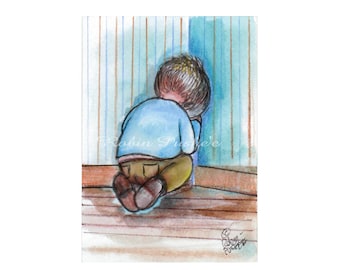
The length of time should be relatively short. The only requirement is that it is out of the way of other activity and within your sight. There is no need to place the chair facing the wall. I would suggest that you set up a chair in some part of the main house like the living room, dining room, or corner of the kitchen.


Time out works best in sight of the parent. For very active children or overly reactive children, time-out is a way to gain some distance from one's emotions long enough to refocus and attend to a task or even remember and apply a rule. Time-out is used to remind the child of the rule as well as reinforce the idea that deviation from it, or refusal to complete a request, are unacceptable behaviors that will not be tolerated. The non-desirable behavior can include breaking a rule such as no hitting, or not complying with a request or expectation such as completing a chore after being told. Should the child refuse to apologize, they shall remain again in timeout for the same additonal minutes depending on their age until they choose to apologize after the expiration of their time.The primary function of time-out is to interrupt a non-desirable behavior and at the same time provide an opportunity for the child to collect herself before continuing to act.Do not pick the child up, otherwise they will think you are apologizing for being cruel. Give them a hug and kiss then move on if they apologize. Asks the child to apologize for the offensive behavior.After the timeout minute expires, parents go to the children and explain again on why they were sent to time-out.Do not let them have a drink or anything to eat when they do this. Should the children leave the zone before the timer goes off, parents must take them back to the zone without talking and reset the timer.Take away items from them (such as a pacifier or sippy cup) so they will think about what that have done. Walk away and set the timer for the said minute. 4-year-olds stay for 4 minutes, 7-year-olds stay for 7 minutes, and ages are sometimes rounded up). Order the child(ren) to remain in the time-out area (not their bedroom) for minutes depending on their age (e.g.

Parent(s) proceed(s) to explain in a low voice why the child(ren) was/were brought to time-out.If the child(ren) repeat(s) his/her/their offending behavior, parents will send them to the designated time-out zone do not have the time-out zone be their bedroom otherwise they would get mix messages or play with their toys.Using authoritative voice while getting down to the child(ren)'s level and giving eye contact, the parent(s) should warn the child(ren) sharply of his/her/their offensive behavior and tell them that they will be sent to time-out should they repeat their actions.Often a corner (hence the common term corner time) or a similar space where the person is to stand or sit during time-outs is designated. The technique involves removing a person from an enriched, enjoyable environment, and therefore lead to extinction of the offending behavior. It is an educational and parenting technique recommended by most pediatricians and developmental psychologists as an effective form of discipline.

This is a form of behavioral modification involves temporarily separating a person from an environment where an unacceptable behavior has occurred.


 0 kommentar(er)
0 kommentar(er)
